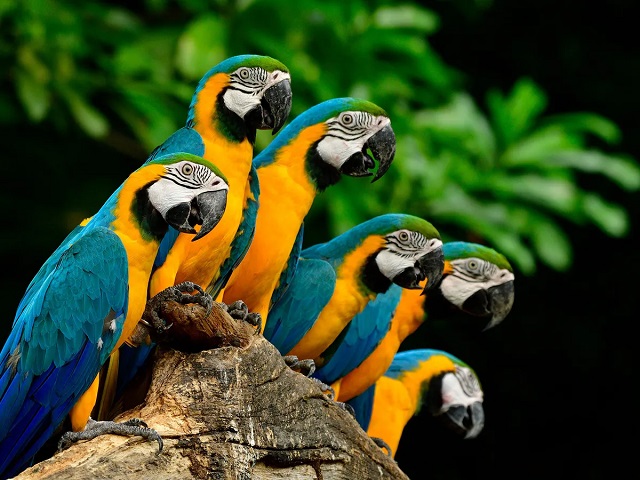
Parrots are birds with strong, curved beaks, upright stances, and clawed feet. They are classified into four families and contain roughly 410 species in 101 genera. Parrots are found mostly in tropical and subtropical regions.
Parrots can be both incredible and demanding friends. Without it, they can become bored or stressed to the point of plucking out their feathers with their strong, hooked beaks. Parrots are entertaining creatures, known for their intelligence, beautiful colours, and ability to mimic human words.
Today we bring to you some interesting, amazing, and fun facts about the bird species, Parrots. They are also known as psittacines.
1. Parrots Have Taste
One incredible fact about parrots is how actively their sense of taste functions, which makes them very exceptional.
While humans have up to 10,000 taste buds on their tongues, parrots only have about 350. For parrots, the buds are located not only on the tongue but also on the back of the throat. The birds’ palates may not seem like much, but they’re functional: The birds can taste bitterness, which helps them avoid potentially poisonous foods and sweetness. And, as parrot owners notice, the birds show preferences for certain foods.
2. Parrots Sing and Talk
Parrots possess a character for being chatty always. The ability to talk and sing remains an incredible and adorable fact about them. Many Parrots have gone global with their verbal abilities. Amazon parrots are renowned singers, including Groucho, who entertained audiences with songs like “How Much Is That Doggie in the Window.”
3. Parrots Have A Long Lifespan
Many parrots’ lifespans are comparable to humans’—a consideration many people don’t truly grasp when seeking a parrot as a companion. Larger species, like macaws and cockatoos, can live between 35 and 50 years in captivity. Tarbu, an African grey in England, lived to the ripe old age of 55. Cookie, a pink cockatoo living at Chicago’s Brookfield Zoo, was the oldest parrot in captivity until he died at nearly 83 years old in 2016.
4. Parrots have Multi-communication Abilities
Parrots have an intricate system of sounds, shrills and squawks that can tell other parrots things, from warning them of predators to telling them there’s food in the vicinity. (Most parrots don’t have many predators except larger birds of prey. When a parrot is younger though, it may have to watch out for things like snakes and even monkeys.)
Some parrots use their feathers to communicate too. Cockatoos have crests on their heads that they can raise or lower at will.
They use these feathers to communicate with other parrots – for instance, to attract a mate, or to warn off potential predators. Some crests in domesticated parrot species are made from selective breeding or mutations.
5. Parrots Can Weigh Up To 7 Pounds
The Kakapo is a nocturnal, flightless parrot that can weigh up to 7 pounds, making it the heaviest of all 250 parrot species.
In addition to its heavy weight and large size, the Kakapo is also considered one of the rarest parrots, as there’s only a shocking number of 126 known to be alive. Thankfully, though, conservation efforts have placed these majestic birds on 3 different predator-free islands where they can hopefully breed and start thriving again.
6. The World’s Smallest Parrot Is Only 3 Inches Long
It’s pretty astounding to think that the world’s smallest parrot has only an average head-to-tail length of just 3-4 inches. Located in New Guinea and the surrounding Pacific islands, Pygmy parrots are fast, agile and downright tiny birds. These exceptionally small parrots are native to New Guinea and the surrounding islands where they forage for food in thick brush and foliage.
Something that’s important to note about this species is that they are one of the only types of parrots that feed on mushrooms and fungi rather than insects.
7. Parrots Build Nests Inside Trees
You might assume that parrots build nests on tree branches like most bird species. While some parrots do build their nests this way, most prefer the additional security of actual holes and hollowed-out areas inside the tree. This offers a greater level of protection against natural predators, allowing the mother parrot to care for her young in a safe, stress-free environment.
Some people assume that parrots aren’t social animals, but this simply isn’t true. On the contrary, parrots crave the attention and affection of their owners. While each and every parrot has their own unique personality, most prefer to spend time with their owners over playing with toys in their cage.
8. Parrots Have A Two-by-two Toe configuration
Most birds have four toes: three in front and one at the back. In contrast, parrots are zygodactyl, which means they have a two-by-two configuration for optimum grip. It is like having two opposable thumbs on each hand.
9. Their Feathers Are Special
Parrot feathers resist long-term damage thanks to a self-defence mechanism against microscopic threats. The birds have bacteria-resistant pigments called psittacofulvins that help maintain their brilliant colours. Exposure to strains has limited effects.
10. Parrots Are Omnivores
Most of their nutrients come from plant sources like fruits, seeds, berries, buds, nuts, pollen, and nectar. However, they can also eat crickets, grasshoppers, mealworms, waxworms, spiders, and silkworms. A few consume clay to release minerals and absorb toxins in the gut.
Food preference depends on the size and place. Small parrots in the southern tropics often consume nectar and pollen. They even have brush-tipped tongues to collect these efficiently. Their digestive systems are well-suited for this diet.
While many other parrot species feed on invertebrate larvae. Others prey on water sails, wood grubs, and insects. Larger ones may be aggressive enough to hunt adult sheep. Some extinct prehistoric parrots had carnivorous diets.
In conclusion, you might be surprised to learn that there are over 360 different parrot species, with more still being discovered. Most people are familiar with the Macaw, African Grey, budgie, etc, but there are hundreds of other species out there. Of course, not all of them are suitable for family pets, so do your independent research before adopting one into your home.



